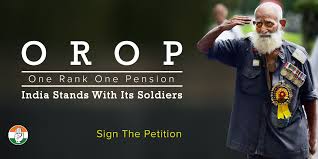excerpt from the Executive Summary on OROP for Mr Soli Sorabjee for Making a Statement in its Support
- One Rank, One Pension (OROP) was already in force for the Armed Forces (AF) till it was quietly removed by the 3rd Pay Commission (PC) in 1973.
OROP has been defined by the Koshiyari (Parliamentary) Committee in 2011 as the same pension for AF personnel retiring in the same rank with the same length of service, with no senior getting less pension than a junior, with increases to those retiring recently to automatically be passed on to those who retired earlier, to be effected in perpetuity.
OROP as announced by the govt has seven major shortcomings: the details are in the attached advertisement.
- The 3rd PC alsoincreased the pensionsof civilian employees from 33% to 50%, and instead of correspondingly increasing those of the AF from 70%, reduced them to 50%. Clubbing civilians with the military was unwise.
- Non-Functional Financial Upgradation (NFFU or NFU) was surreptitiously introduced by the 6th PC in 2006 for 58 Civil Services, classifying them arbitrarily as “Organised Group ‘A’ Services”, but keeping the AF out of its ambit, classifying them as “Class 1 Gazetted Officers” (are the AF considered “DisOrganised Group ‘A’ Services”?). NFU implies that ifanyofficer of a service at any place serves in a post higher than others of his service, the others will get the same pay as the higher one after two years, irrespective of serving in any lower rank.
- This is OROP through the back door, since 80% IAS officials retire as Additional Secretaries vis-à-vis only 0.7% AF officers retiring as equivalents, i.e. Lt Gens. So the IAS get the pensions of Addl Secys.
- The financial burden of NFU for civil services is Rs. 17,000 crore, i.e. twice that of OROP at Rs. 8,293.6 crore.This does not apparently classify as “a burden on the poor”, which OROP is classified as.
- Of the Defence Pension Budget of Rs. 54,000 crore, 45% goes to Defence civilians who are 28% in number; only 55% goes to AF personnel who are 72% of the strength.
- All civilians retire at 60 yrs of age. 80% of AF personnel retire at 34-37 yrs of age,to keep the AF young, as 60-yr-old jawans and officers can not climb the mountains of Siachen and Kargil, leave aside fight there. 90% AF officers retire at 51-54 yrs.
- The early retirement deprives AF personnel from the benefits of one or two PCs, three or four promotions, and corresponding pensions of those ranks.
A jawan suffers a loss of Rs. 5 crore compared to a peon joining service at the same age.
Retired faujis die at 59.6 yrs vis-à-vis retired civilian govt employees at 74 yrs.
AF personnel themselves and not the govt are even paying 100% of the enhanced premia of about twice for life insurance to the Army Group Insurance Fund due to enhanced risks of military service and war vis-à-vis life insurance premia for civilians.
- Having no marketable job skills, the employability of a jawan, Non-Commissioned Officer (NCO) or Junior Commissioned Officer (JCO) after retirement is virtuallyNil: mostly as low-paid security staff; officers mostly as property brokers. Only a minuscule percentage manage to get good jobs. ESM have even been found begging at railway stations or selling vegetables on footpaths, and hiding for shame when seen by erstwhile colleagues.
- Several Parliamentary Committees and finally the Koshiyari Committee considered the views of all stakeholders for and against OROP and unanimously recommended it for AF ESM in 2011, overruling vociferous objections from the babus, on the consideration thatmilitary service can not be compared with civil service.
- The Parliament at the time of the UPA Govt approved OROP.
- The BJP’s Election manifesto assured that OROP would be implemented, an Ex-Servicemen’s (ESMs) Commission, and a War Memorial would be made.
- The President announced these in his speech to Parliament.
- The Parliament at the time of the BJP Govt approved it.
- The Ministry of Defence (MoD) calculated the amounts required separately for Widows, the Disabled, JCOs/NCOs, and officers, with a total requirement of Rs. 8,293.6 crore.
- Various vastly differing, enormous and alarming amounts have been bandied about as rumours, without sharing the details of calculations, whereas the details of Rs. 8,293.6 crore calculated by the MoD are available with them.
- Wild forecasts have been made of immense calculations required to be done every year to keep OROP as OROP, so that no senior gets less pension than a junior, as also passed by the Supreme Court. If not done yearly but five-yearly, over four years juniors will get more pension than seniors, till equalised after five years.
- Such “immense calculations” are already being done annually for the NFU of civil servants! The imaginary problem is forecast only for the AF! The software does the “immense calculations”, not humans. Banks calculate the interest of 4% p.a. on thedaily balancein savings accounts with computers and credit it bi-annually.
- As commented upon by several eminent persons in public life, and even (surprisingly!) by retired Defence Secretary Ajay Prasad, once a decision has already been announced, where is the question of restarting discussion and doing bargaining with the soldiers at this stage, and seeing the distressing sight of soldiers having to go to the streets, for three and a half months, to demand their rights, instead of the govt gracefullysuo motofulfilling the just requirements of its ESM.
- The govt (instigated by the IAS babus who are consumed by the desire to always have the upper hand over all other services) has failed to discern the umbilical bond between the ESM and serving soldiers unique to the AF, 75% of whom are related to them. Those serving see and absorb what to expect from the govt:will they remain motivated to not only fight in future, butfight to win?
(many thanks Lt Col Dhiren Bahl (retd))

Leave a comment